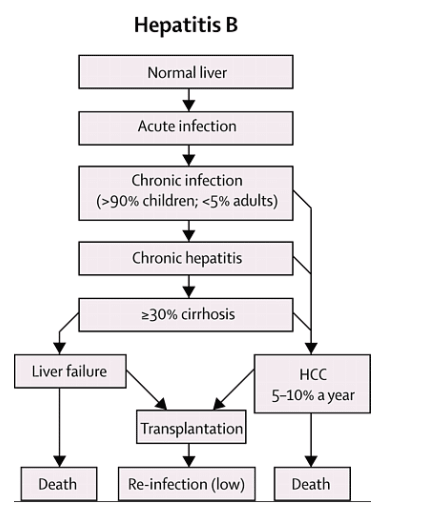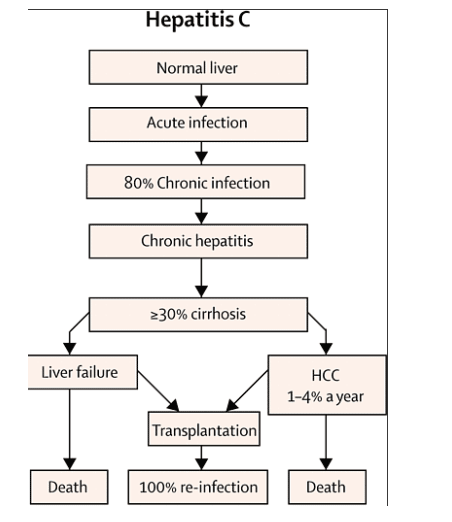| |
Prevention of mortality from hepatitis B and hepatitis C
|
| |
| |
Eugene R Schiff
http://www.thelancet.com
In today's Lancet, Janaki Amin and colleagues report on the causes of death after the diagnosis of hepatitis B and C infection in a community-based setting.1 The striking finding, which comes as no surprise, is that hepatocellular carcinoma (HCC) was the most common liver-related cause of death in those with chronic hepatitis B. Such patients are predisposed to HCC irrespective of the underlying histological severity. Similarly, HCC was a common mode of death in hepatitis C patients, but they usually had underlying cirrhosis (figure).2 In both categories, the risk of HCC could be significantly reduced by prevention of hepatitis B and C infections and early therapeutic intervention for those who already have chronic hepatitis.


There have been safe and effective, active and passive immunisation preparations for hepatitis B for more than 30 years. Worldwide, the primary mode of transmission of the virus is from mother to newborn baby. The earlier this infection is acquired the more likely chronic hepatitis will evolve.3 Perinatal transmission can be effectively interrupted by passive immunisation of the newborn baby with hepatitis B immune globin, together with a series of three active vaccinations starting at birth and given over the subsequent 6 months of life.4 The hepatitis B carrier rate and the risk of HCC has been substantially reduced in Taiwan in children and young adults after the inception of this vaccine policy.5 Universal vaccination throughout the world has been underway to varying degrees for many years and ultimately should sharply reduce the prevalence of hepatitis B disease, in particular the risk of HCC. An estimated 400 million people now have active hepatitis B.
Therapeutic intervention can further reduce the risk of HCC. Liaw and colleagues6 have shown in a placebo-controlled trial that lamivudine, a nucleoside analogue, substantially decreased the rate of life-threatening complications of cirrhosis, including HCC, over a 3-year period. The range of drugs continues to expand and now includes interferon (both standard and pegylated), lamivudine, adefovir, and entecavir\all safe and effective antivirals for hepatitis B disease.7 Additional antivirals are in clinical trials. Most of the treated patients need long-term therapy, and combinations of the oral agents are being recommended to avoid drug-resistant mutations.8
Hepatitis B virus cannot be totally eradicated because residual components remain in the hepatic nuclei (in the form of covalently closed circular DNA). However, continued suppression of hepatitis B virus DNA results in normalisation of liver chemistries and marked improvement in hepatic histological damage, and even reversal of early cirrhosis. Patients who are already in advanced stages of cirrhosis related to hepatitis B virus can now be transplanted without the development of recurrent hepatitis B in the transplanted liver, but liver transplantation is not readily available in many countries and is expensive.9
Unfortunately, there are neither passive nor active vaccines for hepatitis C virus. Most hepatitis C in the world is a result of parenteral transmission either by transfusion of blood products or, more commonly, re-use of syringes, needles, or both. The introduction of blood-donor screening for hepatitis C virus some 16 years ago, as well as hepatitis B virus 35 years ago in developed countries, has virtually eliminated post-transfusion hepatitis. Unfortunately, in underdeveloped countries, particularly in rural areas, blood products remain infected. In Amin and colleagues' study, young people with hepatitis C died disproportionately from complications of drug addiction rather than from liver disease acquired through intravenous drug use. Concerted efforts toward implementing sterile technique and the use of disposable needles and syringes, mainly in health-care settings, are much needed. A more difficult challenge is the worldwide prevention of illicit drug use, as well as treating infected drug users.
For those already infected with hepatitis C, most will develop chronic hepatitis. 30% will develop cirrhosis over a 30-year period and will subsequently develop associated complications, in particular HCC. Pegylated interferon with ribavirin can successfully eradicate this viral infection in around 50% of patients.10 However, this therapy is expensive and the treatment is fraught with side-effects. There are phase II clinical trials underway assessing the safety and efficacy of orally administered antivirals (eg, protease and polymerase inhibitors) that hopefully will eventually lead to even more effective therapy with fewer side-effects. The incidence of HCC secondary to chronic hepatitis C is rising. Some of these patients can be treated with liver transplantation and tumour ablative techniques but, unlike hepatitis B, recurrent infection with hepatitis C virus is almost 100% in recipients of liver transplantation.11
Amin and colleagues have accurately characterised the ravages of chronic hepatitis B and C in their community, which is undoubtedly a refection of thousands of communities throughout the world. The challenge is early detection of these diseases with appropriate preventive measures as well as timely therapeutic intervention.12,13 Hopefully, early antiviral therapy will precede malignant transformation in most patients infected with hepatitis B or C virus.
|
|
| |
| |
|
|
|